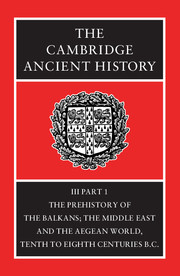Book contents
- Frontmatter
- PART I THE PREHISTORY OF THE BALKANS TO 1000 B.C.
- PART II THE MIDDLE EAST
- 6 Assyria: Ashur-Dan II to Ashur-Nirari V (954–745 B.C.)
- 7 Babylonia c. 1000–748 B.C.
- 8 Urartu
- 9 The Neo-Hittite states in Syria and Anatolia
- 10 Israel and Judah until the Revolt of Jehu (931–841 B.C.)
- 11 Israel and Judah from Jehu until the Period of Assyrian Domination (841–c. 750 B.C.)
- 12 Cyprus
- 13 Egypt: from the Twenty-Second to the Twenty-Fourth Dynasty
- PART III THE BALKANS AND THE AEGEAN
- BIBLIOGRAPHY
- Index
- Map 1. The Palaeolithic and Epipalaeolithic (Mesolithic) periods in Romania
- Map 2. The Neo-Eneolithic period in Romania
- Map 3. The period of transition to the Bronze Age in Romania
- Map 4. The Bronze Age and Hallstatt A period in Romania
- Map 5. Gold and bronze hoards in Romania
- Map 13. Urartu">
- Map 17. Egypt
- References
8 - Urartu
from PART II - THE MIDDLE EAST
Published online by Cambridge University Press: 28 March 2008
- Frontmatter
- PART I THE PREHISTORY OF THE BALKANS TO 1000 B.C.
- PART II THE MIDDLE EAST
- 6 Assyria: Ashur-Dan II to Ashur-Nirari V (954–745 B.C.)
- 7 Babylonia c. 1000–748 B.C.
- 8 Urartu
- 9 The Neo-Hittite states in Syria and Anatolia
- 10 Israel and Judah until the Revolt of Jehu (931–841 B.C.)
- 11 Israel and Judah from Jehu until the Period of Assyrian Domination (841–c. 750 B.C.)
- 12 Cyprus
- 13 Egypt: from the Twenty-Second to the Twenty-Fourth Dynasty
- PART III THE BALKANS AND THE AEGEAN
- BIBLIOGRAPHY
- Index
- Map 1. The Palaeolithic and Epipalaeolithic (Mesolithic) periods in Romania
- Map 2. The Neo-Eneolithic period in Romania
- Map 3. The period of transition to the Bronze Age in Romania
- Map 4. The Bronze Age and Hallstatt A period in Romania
- Map 5. Gold and bronze hoards in Romania
- Map 13. Urartu">
- Map 17. Egypt
- References
Summary
THE RISE AND PROGRESS OF URARTIAN STUDIES
The discovery of Urartu belongs to the heroic period when European scholars first resurrected the civilization of Assyria in the early nineteenth century. It is connected with those studies; but for various reasons the rediscovery of Urartu was much more gradual and took a different course, slower and more erratic than that of Assyria. The first Urartian remains to catch the eyes of the savants of that time, looking out for Assyrian cuneiform inscriptions, were those well preserved on the rock faces or stone slabs around the citadel of the town of Van; a connexion with the Assyrian civilization to the south was obviously to be inferred. In 1828, a French scholar, J. St Martin, who had visited Van in 1823, began to grope towards an explanation by connecting these texts with the garbled legends preserved by an Armenian chronicler, Moses of Khorene (Moses Khorenatsi), probably of the eighth century A.D., according to whom the region was invaded from Assyria by a great army under its queen Semiramis who built a wondrous fortified city, citadel, and palaces at Van itself beside the lake. With this was linked a romantic myth concerning her love for a beautiful semi-divine youth named Ara, a figure of the type of the ‘dying god’. It is clear that by the time of Moses of Khorene all other memory of this kingdom, once the deadly rival of Assyria itself, had been forgotten and remained so, except for these popular legends. They are of as little real value for history as our own Arthurian legends, though the chronicler's vivid and circumstantial description of the great city beside Lake Van seems inspired surely by the great ruins themselves, which no doubt still existed there in a very impressive state of preservation.
- Type
- Chapter
- Information
- The Cambridge Ancient History , pp. 314 - 371Publisher: Cambridge University PressPrint publication year: 1982
References
- 7
- Cited by

